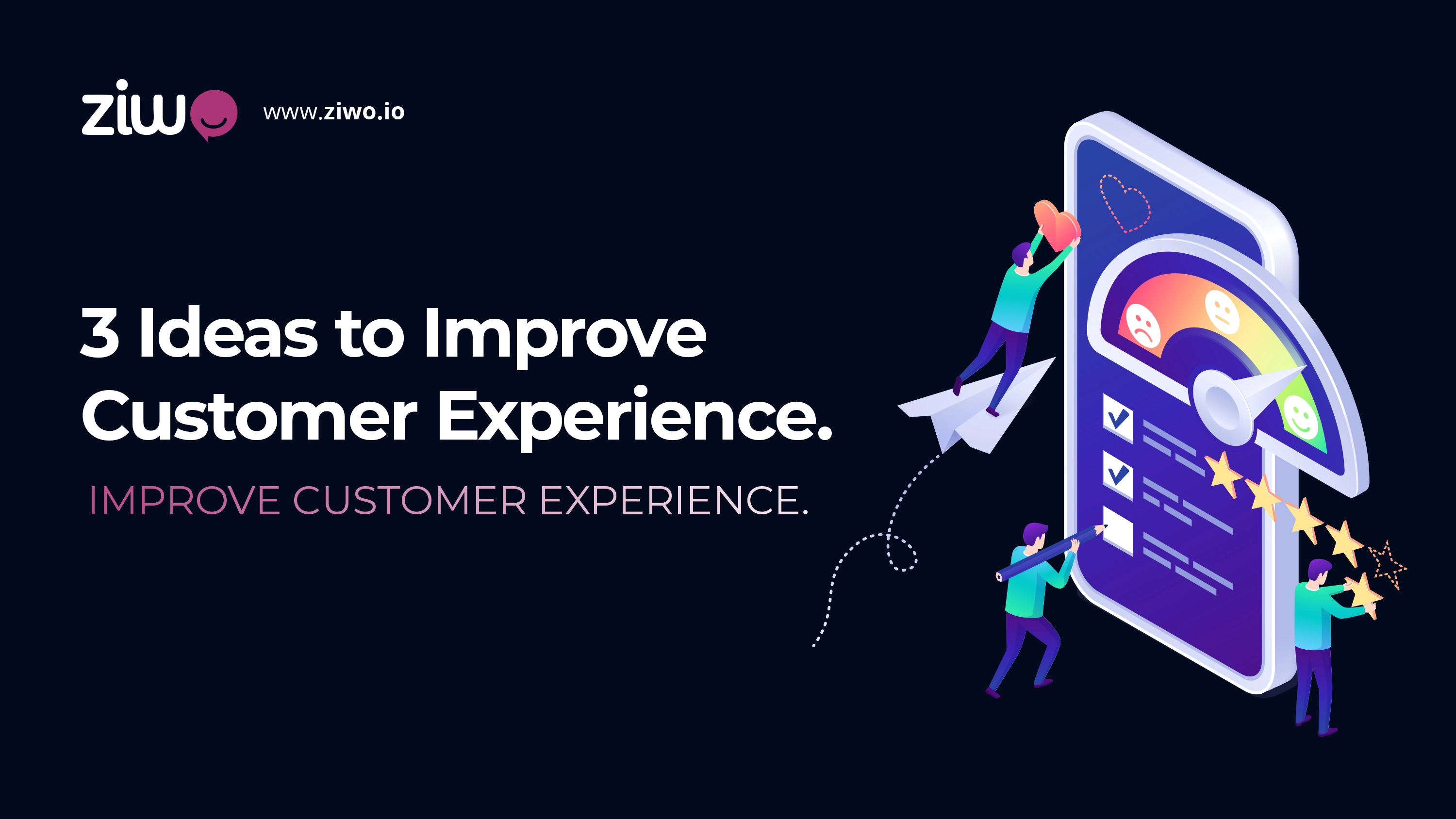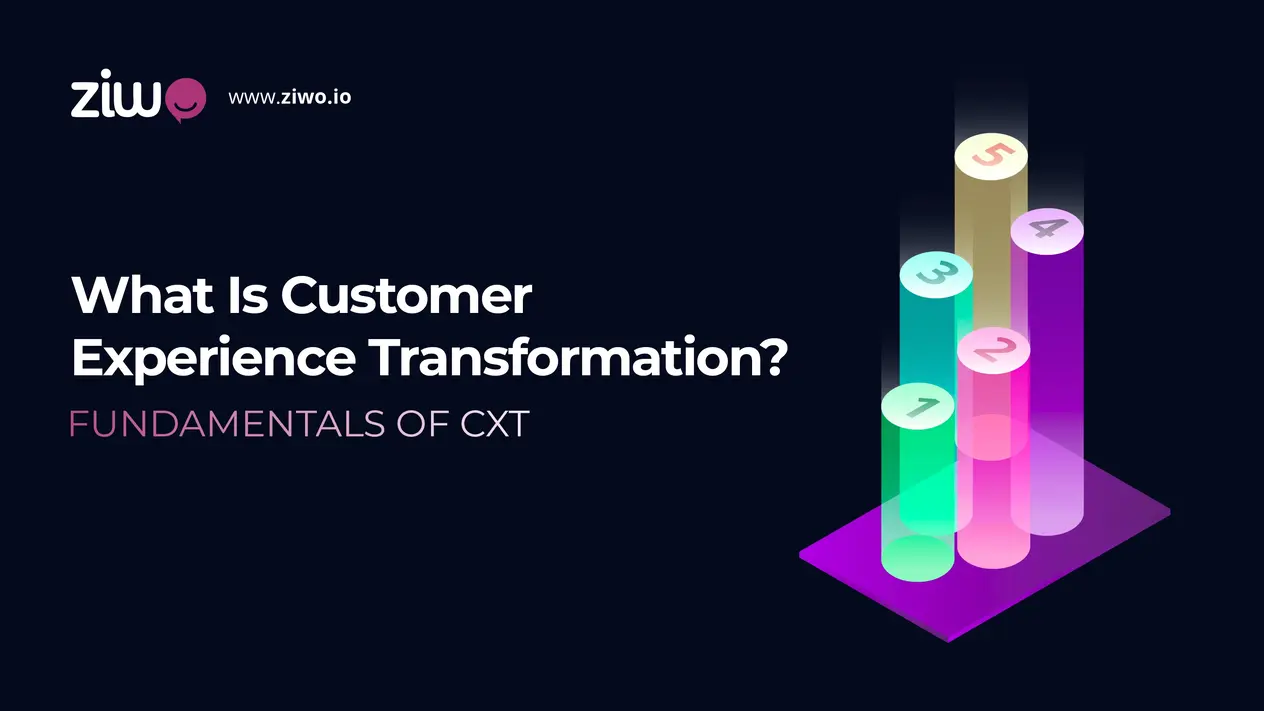La mesure et l'analyse des principaux indicateurs de performance des centres d'appel (KPI) sont absolument essentielles pour évaluer les performances de votre centre d'appel à court et à long terme. Parallèlement, la plupart des responsables de centres d'appels sont conscients de la nécessité de surveiller en permanence les KPI de leur service en tant qu'indication de la satisfaction des clients.
Cependant, tout le monde ne sait pas quels sont les principaux indicateurs à surveiller et quelles sont les normes de l'industrie pour ces indicateurs. Pour le dire autrement, Cet article contient une liste des 15 meilleurs KPI et métriques de centre d'appels à suivre en 2022, Y compris une liste de KPI que nous croyons que chaque gestionnaire de centre d'appels doit surveiller ces 15 KPI, et ce, afin d'améliorer la performance de son département et d'augmenter la fidélisation des clients.
1. Niveau de service
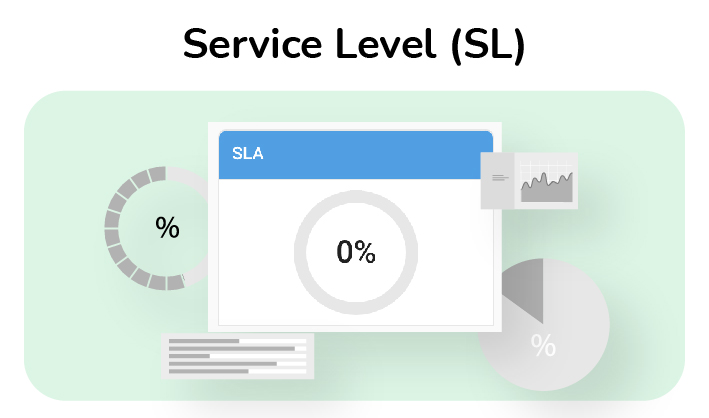
Il s'agit d'un outil permettant de mesurer le pourcentage d'appels reçus dans un certain laps de temps. De même, le niveau de service standard suppose que les opérateurs répondent à 80 % des appels dans un délai de 20 secondes. Il s'agit donc d'un objectif à long terme commun à de nombreux centres d'appels. Bien que cela puisse être vrai, le niveau de service indique si une entreprise dispose de suffisamment de ressources pour mettre tous les clients en contact avec des opérateurs et résoudre leurs problèmes en temps voulu.
Comment améliorer et atteindre votre niveau de service ?
Vous pouvez améliorer votre niveau de service à long terme en procédant simplement comme suit
-En mettant en place un IVR pour couvrir tous les services et réduire le nombre d'appels transmis aux agents.
-En utilisant des techniques ACD intelligentes (files d'attente) basées sur les compétences et les langues des agents.
L'ajout de nouveaux canaux pour l'assistance à la clientèle, tels que les e-mails et WhatsApp.
-Formation approfondie aux compétences non techniques et à la connaissance des produits.
-Répartition des agents du centre d'appels dans différentes files d'attente en fonction de leurs compétences et de leurs langues.
2. Résolution du premier contact (FCR)
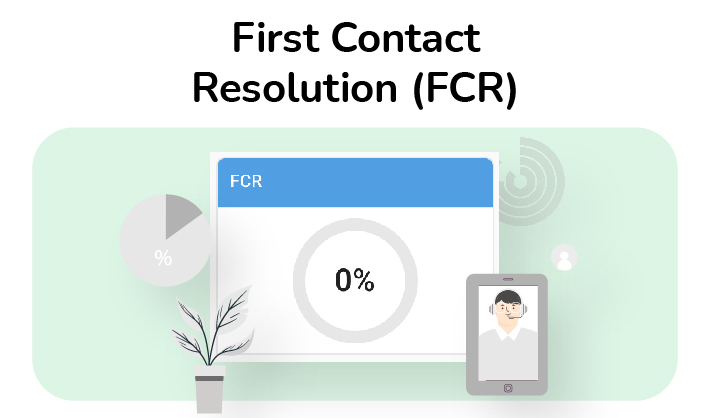
Le FCR est un KPI de base pour les centres d'appels et il représente parfois un véritable défi car il sera très facile à mesurer si votre centre d'appels dispose d'un seul canal de communication, alors qu'il sera plus difficile de le mesurer si vous gérez un centre d'appels omnicanal qui offre une expérience client transparente sur différents canaux, notamment (voix, e-mail, chat, SM, sites Web d'auto-assistance et applications mobiles) ; il est donc préférable de le mesurer par canal.
Il s'agit d'un ICP important pour les centres d'appels qui peut contribuer à améliorer l'expérience client. Il est important de comprendre que les clients souhaitent que leurs questions soient résolues dès le premier appel. Sans parler de la première chose à retenir, lorsque cela se produit, ils sont plus susceptibles d'être plus fidèles à la marque. Sans oublier que la mesure du FCR vous permet d'être performant et de répondre aux besoins de vos clients dès le premier appel.
Comment s'assurer que cet indicateur clé de performance est atteint ?
-Des plans ACD efficaces et intelligents où les appels sont acheminés vers les bonnes files d'attente et où les agents sont affectés en fonction de leurs compétences.
-En organisant des sessions de formation continue pour vos agents.
3) Notation de l'assurance qualité (QA)
L'assurance qualité mesure la qualité des conversations afin de garantir un niveau adéquat de satisfaction des clients et de performance des employés ; elle consiste en un ensemble de critères qui doivent être respectés par l'agent au cours de la conversation téléphonique, notamment la manière dont l'agent accueille le client, l'exactitude des informations qu'il fournit, la manière dont il résout les problèmes du client, etc.
La performance de l'agent est la clé pour mesurer la qualité de l'appel, y compris la rapidité avec laquelle il résout les problèmes du client, la précision avec laquelle il enregistre les informations relatives à l'appel et l'efficacité avec laquelle il passe d'un appel à l'autre.
Comment s'assurer que cet indicateur clé de performance est atteint ?
Assurez-vous de disposer de l'outil d'assurance qualité adéquat et d'une équipe dédiée à l'assurance qualité qui surveillera les appels de votre équipe, travaillera en étroite collaboration avec elle sur ses performances et concevra le programme de coaching en conséquence.
4. Net Promoter Score (NPS)

LeNet Promoter Score (NPS) est un outil de mesure de la fidélité et de l'expérience client. Il s'agit d'une nouvelle méthode de mesure de la satisfaction des clients.
Le NPS est un outil simple mais très puissant pour mesurer la satisfaction et la fidélité de vos clients en leur posant une seule et unique question :
"Quelle est la probabilité que vous recommandiez l'entreprise/la marque/le produit X à un ami/un collègue/un parent ?
La réponse à cette question se fait sur une échelle de 11 points, allant de 0 (pas du tout probable) à 10 (extrêmement probable).

Comment s'assurer que cet indicateur clé de performance est atteint ?
- Réduire le temps de réponse et l'AHT
- Identifier et réaffecter les champions du NPS
- Soyez à l'écoute des besoins de vos clients
- Repenser et supprimer les tâches qui tuent le NPS
- Demandez toujours un retour d'information
- Essayez de vous concentrer sur la reconnaissance de vos détracteurs.
- Assurez-vous d'avoir un parcours client sans faille.
- Créer des programmes de fidélisation.
- Appréciez vos promoteurs et proposez-leur des réductions, des cadeaux ou des offres spéciales.
5. Score de satisfaction client (CSAT)
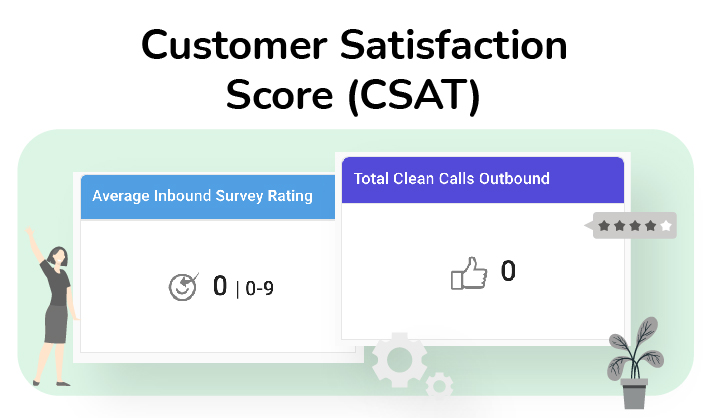
Comme le NPS, le CSAT est un excellent indicateur de la satisfaction des clients. Le CSAT est une bonne mesure pour déterminer si les représentants du centre d'appel offrent une expérience client de qualité inférieure ou supérieure. Toutefois, il faut garder à l'esprit que le CSAT mesure la satisfaction du client à l'égard d'un produit ou d'un service, alors que le Net Promoter Score (NPS) mesure la fidélité du client à l'égard de l'entreprise ou de l'organisation.Souvent, le client se voit présenter une échelle de 1 à 5 et, sur la base d'un système de notation arbitraire, les entreprises classent les réponses en plusieurs sentiments, tels que:
- Très insatisfait
- insatisfait
- Neutre
- Satisfait
- Très satisfait
Comme le NPS, le CSAT est un indicateur clé de la fidélité des clients et du long terme. L'objectif principal de la mesure des scores CSAT est d'identifier les facteurs qui affectent négativement la performance du centre d'appel et ceux qui l'affectent positivement.
6. Score d'effort du client (CES)

Comme le NPS, le Customer Effort Score (CES) est un outil de mesure de la satisfaction client et un indicateur de la fidélité, ce qui en fait un indicateur populaire pour mesurer la performance des centres d'appels. Vous pouvez mesurer le CES en posant une question au client (comme pour le NPS)
Les clients évaluent leur expérience sur une échelle de sept points allant de "très difficile" à "très facile". Ou une variante de cette échelle, de très difficile à très facile sur une échelle de 1 à 5.
Vous pouvez le calculer en trouvant la moyenne de toutes les réponses, c'est-à-dire en prenant la somme totale des réponses et en la divisant par le nombre total de répondants à l'enquête.
7. Taux d'arrivée des appels

Le taux d'arrivée des appels est une mesure du centre d'appels qui permet de suivre le nombre d 'appels reçus par jour au cours des 30 derniers jours, ce qui permet aux responsables d'identifier les tendances.
Grâce à cette mesure, les centres d'appels sont en mesure d'évaluer le nombre total d'appels qu'un agent du centre de contact reçoit dans un laps de temps donné.
8. Pourcentage d'appels bloqués (blocage d'appels)

Lorsque vous mesurez ce pourcentage d'ICP, vous devez déterminer s'il s'agit d'un problème à l'échelle du département ou d'un problème individuel lié à un employé. Les responsables doivent fournir une formation avancée aux employés qui se débattent avec les files d'attente.
S'il s'agit d'un problème à l'échelle du département, vous devrez mettre à niveau le logiciel du centre d'appels afin de pouvoir traiter un plus grand nombre d'appels. Investir dans un meilleur logiciel de centre d'appel peut améliorer les performances globales de votre centre d'appel.

Cet ICP a un impact important sur la satisfaction des clients. Nous pouvons le définir comme le pourcentage d'appelants entrants qui ont reçu la tonalité d'occupation lorsqu'ils ont appelé et qui est souvent causé par l'une des raisons suivantes :
- Il n'y a pas d'agents disponibles et aucune file d'attente n'est configurée (ou les files d'attente sont pleines), de sorte que les appelants entendent une tonalité d'occupation lorsqu'ils appellent ou sont directement dirigés vers la messagerie vocale.
- Le logiciel du centre d'appel ne peut pas gérer le volume d'appels de manière adéquate.
Un seul appel bloqué est considéré comme une occasion manquée d'entrer en contact avec un client ou un prospect. Il s'agit d'un indicateur de performance clé très important pour les centres d'appels et les responsables de ces centres ne doivent pas l'ignorer.
9. Taux d'appels abandonnés (taux d'abandon)

Le taux d'abandon des appels donne aux managers un aperçu du nombre d'appelants déconnectés de l'appel avant qu'ils n'interagissent avec un agent d'appel. Sans oublier que ce KPI est un outil permettant de mesurer les appels qui ont été abandonnés dans l'IVR et la file d'attente.

Comment s'assurer que cet ICP est atteint ?
- Planification stratégique des effectifs (disposer d'un nombre suffisant d'agents couvrant les heures de pointe).
- Soutenir les prévisions et optimiser la planification des agents du centre d'appels.
- En utilisant la technologie de rappel.
- En améliorant les messages dans la file d'attente et en évitant les longues options IVR.
10. Temps de traitement moyen (AHT)
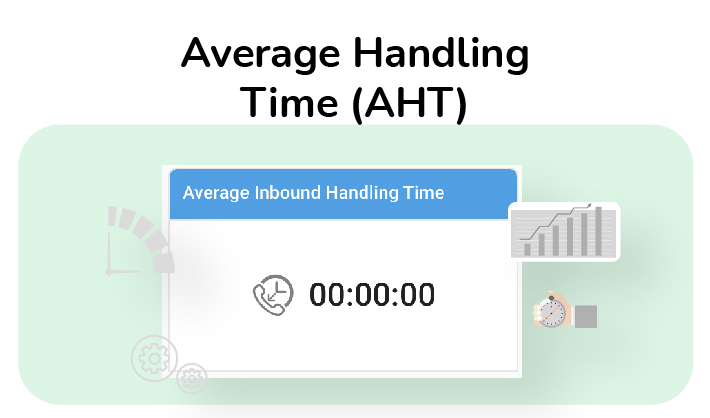
Le terme Temps de traitement moyen (AHT) est un KPI de centre d'appel qui représente le temps moyen que prend un représentant du service clientèle pour terminer une transaction. En fait, l'AHT inclut typiquement le temps et les tâches qu'un client suit l'appel ou l'interaction jusqu'à ce que l'agent commence l'appel ou le chat suivant. Cet ICP est une mesure clé pour tout système de planification de centre d'appels, car il indique le temps de traitement d'un nouvel appel, et pas seulement le temps de conversation.
L'objectif de nombreux centres d'appels est de réduire l'AHT, de maximiser l'efficacité et d'augmenter le SL.
Cependant, cela peut avoir un impact négatif sur la qualité du service.

Voici quelques moyens de réduire l'AHT sans influencer la qualité du service :
- Créer des scripts pour le centre d'appel et des réponses standardisées afin que les agents ne perdent pas de temps à répondre aux questions fréquemment posées par les clients.
- L'unification de tous les outils utilisés par l'agent sur un seul écran au lieu de passer d'un écran à l'autre augmente le temps de conversation et/ou d'attente pendant l'appel.
- Enregistrer tous les appels afin de détecter les problèmes et d'en tirer des enseignements lors des sessions de formation. En outre, comprendre la raison des temps d'attente et d'ACW élevés ou répétés permettra de mieux gérer le temps de traitement et vous aidera à concevoir des programmes de formation en conséquence.
11. Temps de clôture/travail après appel (TCA)
Le temps de clôture ou le temps de travail moyen après appel est un excellent moyen de mesurer la productivité des agents du centre d'appel. Le temps de travail moyen après appel mesure le temps moyen nécessaire aux agents pour effectuer le travail associé à un appel une fois celui-ci terminé.
Vous avez besoin que vos agents passent suffisamment de temps pour effectuer ce travail avec précision et minutie. Cependant, si vous constatez que le temps moyen de travail après appel est trop élevé, il se peut qu'il y ait un autre problème.

Vous pouvez ajouter à votre plateforme de centre d'appels la valeur du temps de clôture ou ACW. Cette valeur est basée sur votre calcul historique de la durée moyenne du travail après appel et sur son impact sur le niveau de service.
12. Vitesse moyenne de réponse (ASA)
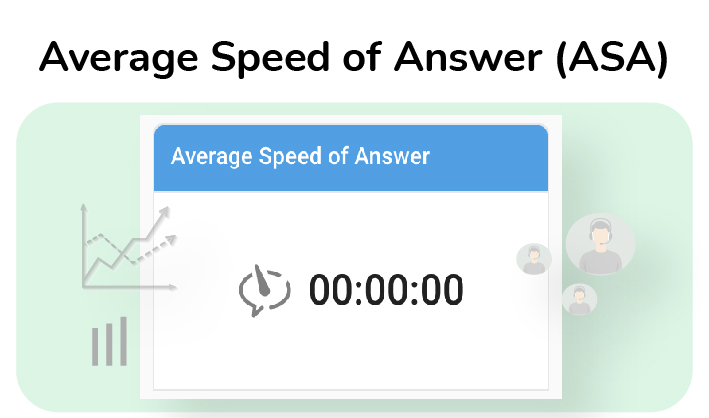
Cette mesure critique permet aux centres d'appels d'évaluer le temps nécessaire aux agents pour répondre à un appel en attente.
 Lorsque cette mesure est trop élevée, cela peut signifier que les agents prennent trop de temps pour répondre aux appels ou pour prendre de nouveaux appels.
Lorsque cette mesure est trop élevée, cela peut signifier que les agents prennent trop de temps pour répondre aux appels ou pour prendre de nouveaux appels.
13. Occupation
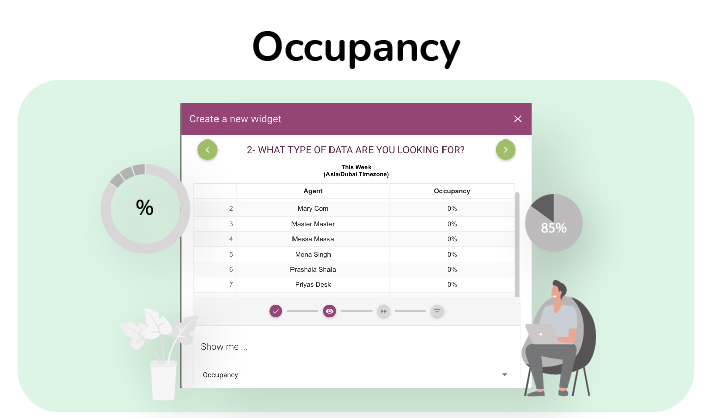
De nombreux professionnels pensent à tort que l'occupation et l'utilisation sont identiques alors qu'il s'agit de mesures complètement différentes.
Qu'est-ce que l'occupation ?
L'occupation est un pourcentage qui représente le temps que les conseillers consacrent aux activités liées aux appels alors qu'ils sont disponibles et censés prendre des appels. L'activité liée aux appels comprend le temps de parole, le temps d'attente et le temps de conclusion. Il est très courant que de nombreuses personnes l'appellent "temps productif".

Le taux d'occupation d'un centre d'appel se situe généralement entre 80 et 85 %. Dans ce cas, si votre taux d'occupation se situe à ce niveau, il est probable que votre équipe de planification des ressources fasse du bon travail ! En revanche, si le taux d'occupation est constamment supérieur à 85 %, vous risquez l' épuisement professionnel des agents.
14. L'utilisation
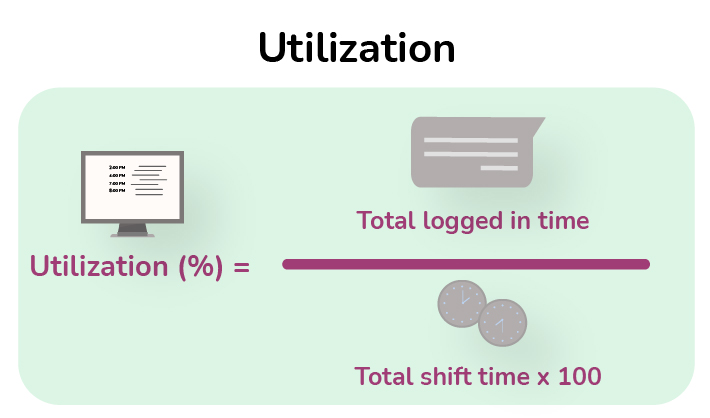
Comme l'occupation, l'utilisation est un pourcentage. En revanche, elle diffère de l'occupation. En effet, l'utilisation représente plutôt le temps que les conseillers passent connectés tout en étant présents dans le centre d'appel.

Cette mesure représente le pourcentage de temps que les agents du centre d'appel consacrent à la gestion des appels, aux interactions avec les clients et au travail lié aux appels.
15. Temps de première réponse (FRT)

S'assurer que les représentants du centre d'appel traitent les demandes rapidement laisse une impression durable sur les appelants à long terme. Vous pouvez calculer cet ICP sur une base horaire, plusieurs jours par semaine et sur une base annuelle.

Selon de nombreuses études, environ 45 % des appelants quittent un appel au cours de la première minute d'attente. Sans oublier qu'après trois minutes d'attente, un pourcentage étonnant de 70 % des appelants quitteront l'appel.
Comment réduire le temps de première réponse ?
-En adoptant l'approche omnicanale : Pour réduire le délai de première réponse, le centre d'appel peut commencer à fournir une assistance à la clientèle sur plusieurs canaux, notamment WhatsApp, les médias sociaux, les courriels et le courrier électronique. Cela inclut WhatsApp, les médias sociaux, le courrier électronique, le chat et les SMS.
Encadrement adéquat du personnel : la formation permet de s'assurer qu'un agent en poste n'est pas désemparé. En outre, elle permet à l'équipe de se tenir au courant des processus à suivre pendant et après l'appel. Cela permet de gagner du temps et de réduire le TFR.



